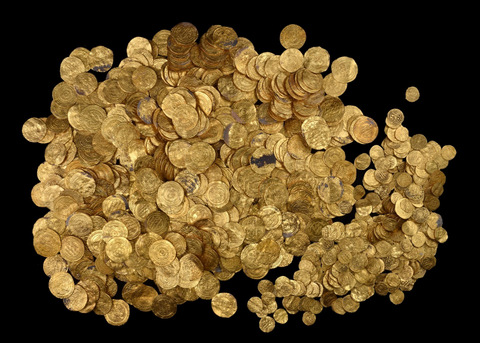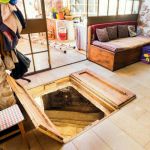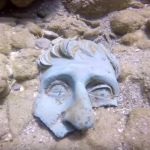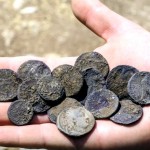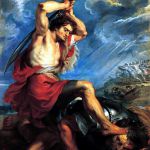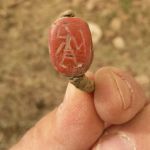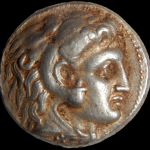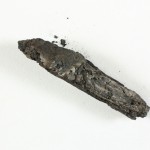Israeli divers exploring the ancient harbor in Caesarea National Park recently discovered the largest hoard of gold coins ever found in Israel.
The divers immediately alerted the Israel Antiquities Authority (IAA) and brought them to the spot where over 2,000 gold coins from the Fatimid period (11th century AD) glistened on the seabed. Included in the collection are various denominations such as dinars, half dinars and quarter dinars.
The director of the Marine Archaeology Unit of the Antiquities Authority, Kobi Sharvit, speculates that there is a wrecked treasure ship in the area that must have sunk while carrying tax revenue to the central government in Cairo. It is also possible that the gold was to pay salaries of the local Fatimid military garrison, or they may belong to a merchant ship.
It could have also been used as redemption money.
Documents in the Cairo Geniza (a storeroom of the Ben Ezra Synagogue in Fustat or Old Cairo, Egypt where 300,000 Jewish fragments from the 11th and 12th century were discovered) tell of the redemption of Jewish prisoners from Ashkelon by the Jewish community in the amount of five hundred gold dinars to return them to Israel. (IAA)
Expert numismatist Robert Cole said, “The Fatimids controlled a vast empire, from Morocco in the west, to Iraq in the east. They controlled trade routes all over the Mediterranean, bringing gold from West Africa to Europe and the Middle East.”
Cole said that several of the coins actually exhibit teeth marks showing that they had been tested for authenticity by merchants. He notes that although they are almost a millennium in age, they do not require any cleaning or conservation. (JPost)
There are laws against illegally removing such artifacts. The IAA recently arrested scavengers in Qumran who faced up to five years in jail for looting the caves where the Dead Sea Scrolls were found.
Sharvit said that divers Tzvika Feuer, Kobi Tweena, Avivit Fishler, Yoav Lavi, Yoel Miller, and Zvika Fayer are model citizens.
“They discovered the gold,” he said, “and have hearts of gold that love the country and its history.” (JPost)
The divers described how at first they thought they were looking at toy coins, but once they realized that they were the real thing they collected several and brought them to the director of the dive club who informed the IAA Marine Archaeology.
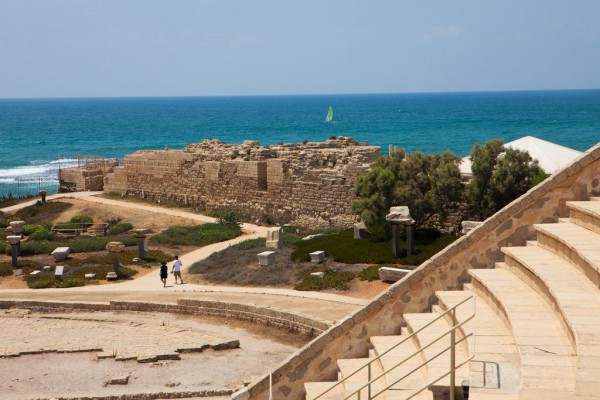
Caesarea Maritima is a national park in Israel, near the town of Caesarea. After the destruction of Jerusalem in AD 70, Caesarea became the provincial capital of the Judea Province. (Israel Tourism Photo)
“We went diving on February 7, as we do almost every Saturday,” Zvika Fayer said.
“We were diving 12, maybe 12.5 meters under sea surface. I saw a flickering on the bottom of the Mediterranean, so I swam there and started digging with my bare hands. Other members of my diving group joined me and we discovered a significant amount of coins. After the dive was over, we contacted the Israel Antiquities Authority and notified them about our discovery.” (JP)
While most of the coins were minted under the authority of the Fatimid caliphs of Egypt, Al-Hakim (AD 996–1021) and his son Al-Zahir (1021–1036), the oldest is a quarter dinar minted in Palermo, Sicily in the late 9th century.
The Marine Archaeological Unit of the Israel Antiquities Authority will be carrying on salvage excavations with the hope that it will be possible to supplement our understanding of the entire archaeological context, and eventually answer the many questions that still remain regarding the treasure. (IAA)




